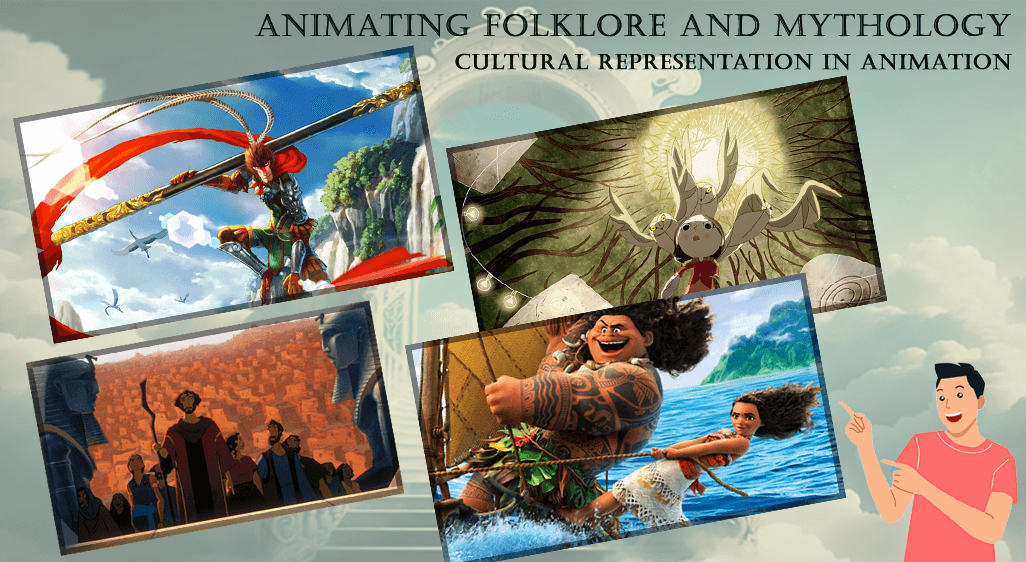The art of animation has come a long way since its inception, transcending the boundaries of creativity and imagination. Animation has the unique ability to bring stories to life, making them more accessible and engaging. While it has been a powerful medium for storytelling, animation also serves as a mirror for society, reflecting our cultures, beliefs, and myths. In this blog, we’ll delve into the world of folklore and mythology and explore how animation plays a vital role in cultural representation.
The Unveiling of Folklore and Mythology
Folklore and mythology have been integral parts of every culture throughout history. They are the living remnants of traditions, legends, and stories passed down through generations. These narratives often contain valuable life lessons, moral values, and historical events that define a culture’s identity. Animation, with its captivating visuals and emotional storytelling, becomes a perfect vehicle to convey these narratives to a global audience.
Embracing Cultural Diversity
One of the most beautiful aspects of folklore and mythology is their diversity. Each culture has its own unique set of stories, gods, heroes, and mythical creatures. By animating these tales, creators can introduce the world to the richness of various cultures, fostering appreciation and understanding.
For example, the story of the Monkey King from Chinese mythology has been adapted into numerous animations, including the popular series “Monkey King: Hero Is Back.” This animation has introduced the character to audiences worldwide, promoting Chinese culture and mythology.
Breaking Stereotypes
Animation provides a platform to challenge stereotypes and misconceptions about different cultures. By accurately representing folklore and mythology, creators can dispel biases and prejudices, promoting tolerance and respect. For instance, the Disney film “Moana” drew inspiration from Polynesian mythology, creating a strong and independent Polynesian heroine, Moana, who breaks away from the stereotypes often associated with Pacific Islanders.
The Power of Visual Storytelling
Folklore and mythology are inherently rich in visual elements. These stories are often accompanied by vivid descriptions of gods, magical realms, and epic battles. Animation can bring these elements to life in a way that no other medium can.
Engaging Young Audiences
Animation aimed at children is particularly influential in educating the younger generation about their cultural heritage. By incorporating folklore and mythology into children’s animation, we can ensure that these stories continue to be passed down to future generations. “Epic” is an animation that weaves together elements of Irish mythology, creating an enchanting tale for young audiences.
Reviving Forgotten Stories
Many cultures have folklore and mythology that are at risk of being forgotten. By creating animated adaptations, these stories are not only preserved but also revitalized. “Kubo and the Two Strings,” inspired by Japanese folklore, introduces audiences to the world of origami and ancient Japanese traditions, rekindling interest in these fading cultural aspects.
Challenges and Responsibilities
While animation has the potential to amplify the voices of diverse cultures, it also carries certain responsibilities.
Cultural Sensitivity
Animating folklore and mythology requires a deep understanding of the culture being represented. Creators must exercise great care to ensure they are portraying these stories accurately and respectfully. Misrepresentation or cultural appropriation can perpetuate harmful stereotypes and misconceptions.
Balancing Tradition and Innovation
Adapting folklore and mythology into animation often requires finding a balance between tradition and innovation. Creators must respect the core elements of these stories while also making them relatable and engaging for modern audiences. This challenge can be seen in the animation “Song of the Sea,” which beautifully combines Irish folklore with contemporary storytelling.
The Future of Cultural Representation in Animation
As the animation industry continues to evolve, we can expect an even more profound exploration of folklore and mythology. Here are some trends and innovations to look forward to:
Interactive Storytelling
Emerging technologies, such as virtual reality and augmented reality, allow audiences to immerse themselves in the world of folklore and mythology. Interactive storytelling provides a more engaging and educational experience.
Global Collaborations
Collaborations between animators from different parts of the world can lead to unique and culturally enriching projects. By combining their expertise, creators can introduce audiences to lesser-known mythologies and stories.
Crowdsourced Content
With the advent of digital platforms, audiences are increasingly participating in content creation. This trend can lead to diverse and authentic representations of folklore and mythology.
Celebrating Cultural Heritage
Animation is a powerful tool for cultural representation, giving folklore and mythology a global stage. When used responsibly and respectfully, animation can bridge cultural gaps, preserve ancient traditions, and break down stereotypes. As we continue to explore the world’s diverse narratives, animation remains a vital medium for animating folklore and mythology, celebrating the rich tapestry of human heritage.
Preserving Our Stories
It is crucial to recognize the importance of preserving our cultural stories. Animation is not just a form of entertainment; it is a means to safeguard our heritage. By transforming these stories into animated tales, we ensure that they remain vibrant and relevant for future generations.
Final Thoughts
The relationship between animation and cultural representation is a dynamic and evolving one. With each new animated film or series, we have the opportunity to celebrate the diversity of our world and educate future generations about the rich tapestry of human history. As creators and consumers of animation, we should embrace this medium’s potential to unite us through shared stories and values, making the world a more culturally aware and empathetic place.












